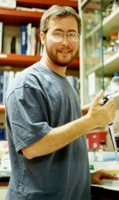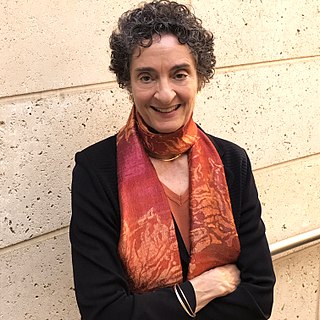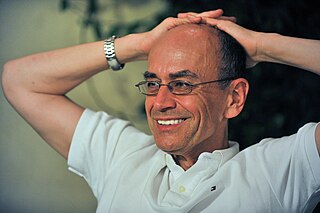Related Research Articles
Stanford University School of Medicine is the medical school of Stanford University and is located in Stanford, California. It traces its roots to the Medical Department of the University of the Pacific, founded in San Francisco in 1858. This medical institution, then called Cooper Medical College, was acquired by Stanford in 1908. The medical school moved to the Stanford campus near Palo Alto, California, in 1959.

A neuroscientist is a scientist who has specialised knowledge in neuroscience, a branch of biology that deals with the physiology, biochemistry, psychology, anatomy and molecular biology of neurons, neural circuits, and glial cells and especially their behavioral, biological, and psychological aspect in health and disease.

Neurotrophins are a family of proteins that induce the survival, development, and function of neurons.
Elliot Meyerowitz is an American biologist.

The p75 neurotrophin receptor (p75NTR) was first identified in 1973 as the low-affinity nerve growth factor receptor (LNGFR) before discovery that p75NTR bound other neurotrophins equally well as nerve growth factor. p75NTR is a neurotrophic factor receptor. Neurotrophic factor receptors bind Neurotrophins including Nerve growth factor, Neurotrophin-3, Brain-derived neurotrophic factor, and Neurotrophin-4. All neurotrophins bind to p75NTR. This also includes the immature pro-neurotrophin forms. Neurotrophic factor receptors, including p75NTR, are responsible for ensuring a proper density to target ratio of developing neurons, refining broader maps in development into precise connections. p75NTR is involved in pathways that promote neuronal survival and neuronal death.

Ben A. Barres was an American neurobiologist at Stanford University. His research focused on the interaction between neurons and glial cells in the nervous system. Beginning in 2008, he was chair of the Neurobiology Department at Stanford University School of Medicine. He transitioned to male in 1997, and became the first openly transgender scientist in the National Academy of Sciences in 2013.

Carla J. Shatz is an American neurobiologist and an elected member of the American Academy of Arts and Sciences, the American Philosophical Society, the National Academy of Sciences, and the National Academy of Medicine.
Viktor Hamburger was a German-American professor and embryologist. His collaboration with neuroscientist Rita Levi-Montalcini resulted in the discovery of nerve growth factor. In 1951 he and Howard Hamilton published a standardised stage series to describe chicken embryo development, now called the Hamburger-Hamilton stages. He was considered "one of the most influential neuroembryologists of the twentieth century".

Theodore Holmes Bullock is one of the founding fathers of neuroethology. During a career spanning nearly seven decades, this American academic was esteemed both as a pioneering and influential neuroscientist, examining the physiology and evolution of the nervous system across organizational levels, and as a champion of the comparative approach, studying species from nearly all major animal groups—coelenterates, annelids, arthropods, echinoderms, molluscs, and chordates.
Tobias Bonhoeffer is a German neurobiologist. He is director at the Max Planck Institute of Neurobiology and head of the department Synapses – Circuits – Plasticity.
Richard Lewis Huganir is a Bloomberg Distinguished Professor in the Departments of Neuroscience and Psychological and Brain Sciences, Director of the Solomon H. Snyder Department of Neuroscience, and co-director of the Johns Hopkins Medicine Brain Science Institute at the Johns Hopkins University School of Medicine. He has joint appointments in the Department of Biological Chemistry and the Department of Pharmacology and Molecular Sciences in the Johns Hopkins School of Medicine.

Thomas Christian Südhof, ForMemRS, is a German-American biochemist known for his study of synaptic transmission. Currently, he is a professor in the School of Medicine in the Department of Molecular and Cellular Physiology, and by courtesy in Neurology, and in Psychiatry and Behavioral Sciences at Stanford University.

Azad Bonni is a Canadian and American neuroscientist of Kurdish origin. The focus of his research is to understand the mechanisms of neuronal connectivity in the brain. From October 2012 until June 30, 2019, he was the Edison Professor of Neuroscience and Chairman of the Department of Neuroscience at Washington University School of Medicine. As of July 1, 2019, he is SVP and head of neuroscience and rare diseases research and early development at Roche in Basel, Switzerland.
Rosalind Anne Segal is an American neurobiologist. She is a Professor of Neurobiology at Harvard Medical School and the Co-Chair of the Cancer Biology Department at the Dana Farber Cancer Institute. Segal's work employs modern methods of cell and molecular biology to study the development of the mammalian brain with the goal of understanding how disruption of this normal process leads to the formation of brain malignancies.

Randal J. Kaufman is the director and a professor of the Degenerative Diseases Program, Neuroscience and Aging Center at Sanford Burnham Prebys Medical Discovery Institute (SBP) and an adjunct professor in the Department of Pharmacology at the UC San Diego School of Medicine.

Elizabeth Roboz-Einstein was a biochemist and neuroscientist known for purifying and characterizing myelin basic protein (MBP), investigating its potential role in the neurodegenerative disease multiple sclerosis (MS), and helping pioneer the field of neurochemistry.
Hans Thoenen was a Swiss neurobiologist best known for his work on neurotrophins.
Moses V. Chao is a neuroscientist and university professor at NYU Langone Health Medical Center. He studies the mechanisms of neuronal growth factor and teaches courses in cell biology, neuroscience, and physiology. He is a Fellow of the American Association for the Advancement of Science and was President of the Society for Neuroscience in 2012.
Lorne Mendell is a neurobiologist currently employed as a distinguished professor in the department of neurobiology and behavior at Stony Brook University in New York. His research focuses primarily on neurotrophins in neonatal and adult mammals, and on the neuroplasticity of the mammalian spinal cord. Mendell's research interests lie in other areas including pain, nerve wind-up, and specifically the neurotrophin, NT-3. His research has contributed findings to the growing pool of knowledge of axonal development and regeneration of immature and mature neurons. Mendell has been a part of the search for novel treatments for spinal cord injuries and continues to study neurotrophins to determine their effects on neuronal plasticity. Mendell served a term as the President for the Society of Neuroscience during the years 1997-1998.
Patrizia Casaccia is an Italian neuroscientist who is the Director of the Neuroscience Initiative of the Advanced Science Research Center at the City University of New York (CUNY), as well as a Professor of Neuroscience, Genetics & Genomics, and Neurology at the Icahn School of Medicine at Mount Sinai. Casaccia is a pioneer in the study of myelin and her research focuses on understanding the neurobiological and neuroimmune mechanisms of multiple sclerosis to translate their findings into treatments. Casaccia co-founded the Center for Glial Biology at Mount Sinai and CUNY and is one of the Directors of the center.
References
- 1 2 3 4 5 "Eric Shooter, founding chair of Department of Neurobiology, dies at 93". News Center. 29 March 2018. Retrieved 16 October 2018.
- 1 2 "Eric Shooter". Royal Society. 19 September 2015. Retrieved 16 October 2018.
- 1 2 "Eric Shooter - Emeritus Lecture Program". Stanford University School of Medicine. Retrieved 16 October 2018.
- ↑ "APS Member History". search.amphilsoc.org. Retrieved 11 October 2021.
- ↑ "A life in science: Eric Shooter - Office of Communications & Public Affairs - Stanford University School of Medicine". mednews.stanford.edu. 15 July 2007. Archived from the original on 15 July 2007. Retrieved 16 October 2018.